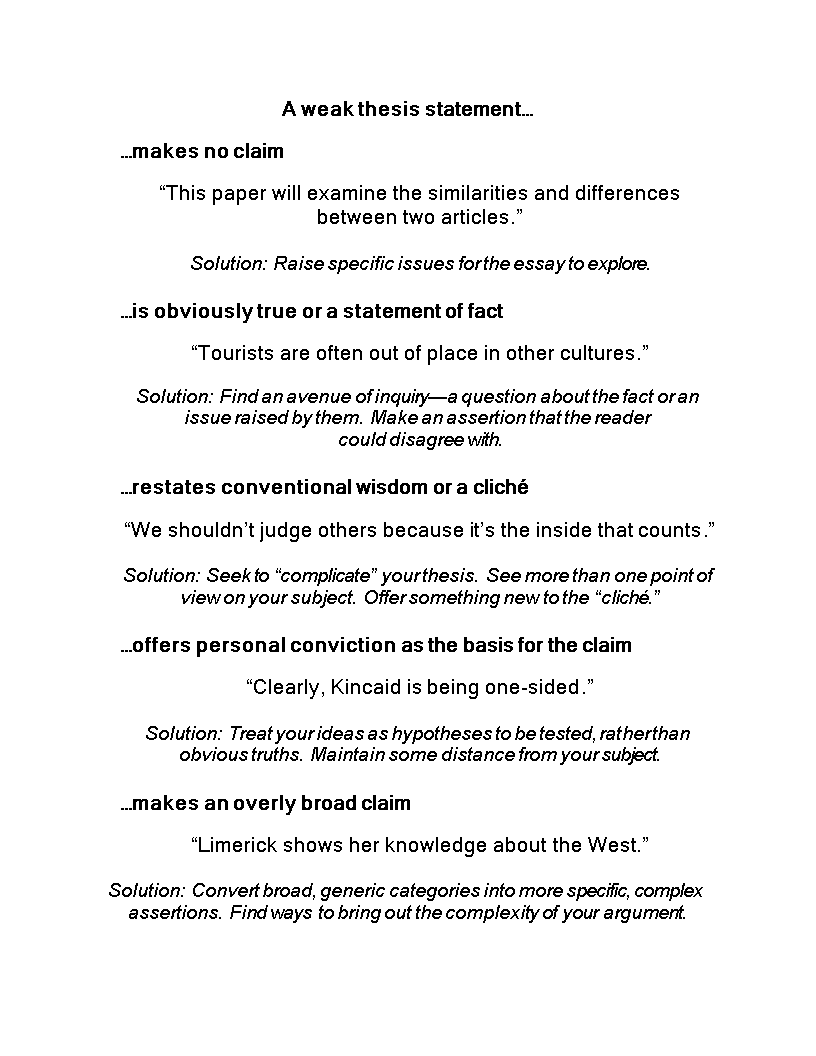Weak Thesis Statement
Save, fill-In The Blanks, Print, Done!

Download Weak Thesis Statement
Microsoft Word (.doc)Or select the format you want and we convert it for you for free:
- This Document Has Been Certified by a Professional
- 100% customizable
- This is a digital download (55.5 kB)
- Language: English
- We recommend downloading this file onto your computer.
How to draft a Weak Thesis Statement? An easy way to start completing your document is to download this Weak Thesis Statement template now!
Every day brings new projects, emails, documents, and task lists, and often it is not that different from the work you have done before. Many of our day-to-day tasks are similar to something we have done before. Don't reinvent the wheel every time you start to work on something new!
Instead, we provide this standardized Weak Thesis Statement template with text and formatting as a starting point to help professionalize the way you are working. Our private, business and legal document templates are regularly screened by professionals. If time or quality is of the essence, this ready-made template can help you to save time and to focus on the topics that really matter!
Using this document template guarantees you will save time, cost and efforts! It comes in Microsoft Office format, is ready to be tailored to your personal needs. Completing your document has never been easier!
Download this Weak Thesis Statement template now for your own benefit!
Structure of the class session on this topic: 1) Students share their written statements with members of their 3-person Writing/Discussion Groups and discuss four issues: a) Do the other two members of the group think that the theoretical approach the other student uses is a good explanation of the imaginative component of the poem in question b) Might any of the theoretical insights into poetry and poetic structure that that the student was not able to apply to his or her choice of imaginative poems indeed contribute to a fuller understanding of the poem c) As a result of discussing a and b above, each student should list the gaps they see in their understanding of how aspects of the imagination works in their chosen poem(s).. What more, therefore, needs to be further explained What aspect of their knowledge or understanding is inadequate d) With the help of the other two students in the group, each student should formulate an introductory statement (for an essay) which would state what he or she understands about how and where the imagination is at work in one or another poem they ve chosen and what they think, therefore, a reader might also readily recognize and understand about the poem--but then also specify what further issues or aspects of the imaginative elements of the poem they would wish to know, or wish to be able to explain more fully.. I ask, What do you notice about the structure and order of information How many sentences has the writer kept from the draft I point out that the writer could not have gotten to the clearer articulation of her ideas without having written the draft first ( this comment may not really register with them at this point, but I bring it up again in draft conferences, especially when students are dismayed at having to start over.. I ask them to look at the information they provide in their intros what contextual information is necessary to understand the problem/response and what is extraneous (Here, I might point out that in
DISCLAIMER
Nothing on this site shall be considered legal advice and no attorney-client relationship is established.
Leave a Reply. If you have any questions or remarks, feel free to post them below.
Related templates
Latest templates
Latest topics
- Excel Templates
Where do I find templates for Excel? How do I create a template in Excel? Check these editable and printable Excel Templates and download them directly! - GDPR Compliance Templates
What do you need to become GDPR compliant? Are you looking for useful GDPR document templates to make you compliant? All these compliance documents will be available to download instantly... - Google Docs Templates
How to create documents in Google Docs? We provide Google Docs compatible template and these are the reasons why it's useful to work with Google Docs... - IT Security Standards Kit
What are IT Security Standards? Check out our collection of this newly updated IT Security Kit Standard templates, including policies, controls, processes, checklists, procedures and other documents. - Letter Format
How to format a letter? Here is a brief overview of common letter formats and templates in USA and UK and get inspirited immediately!
cheese

